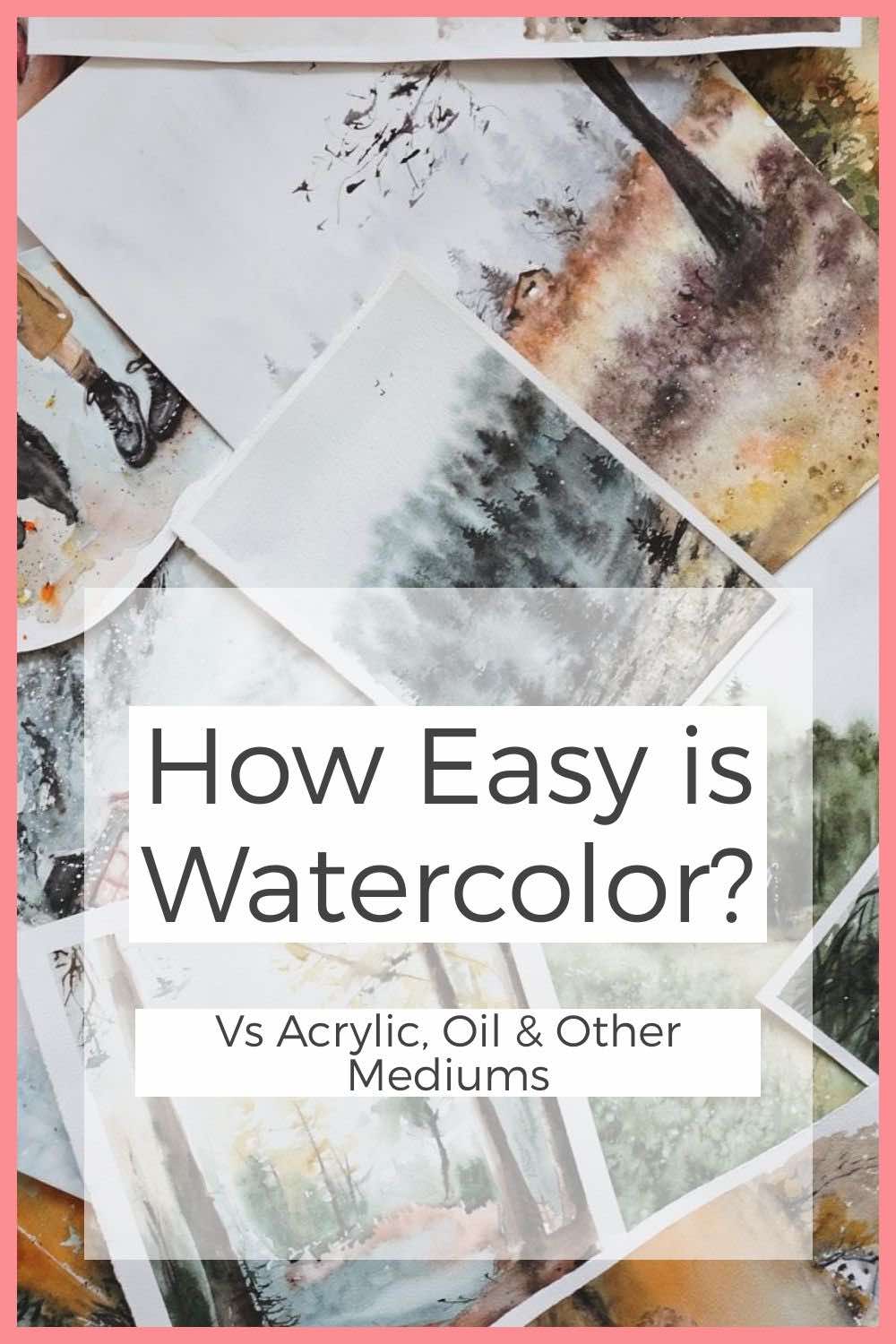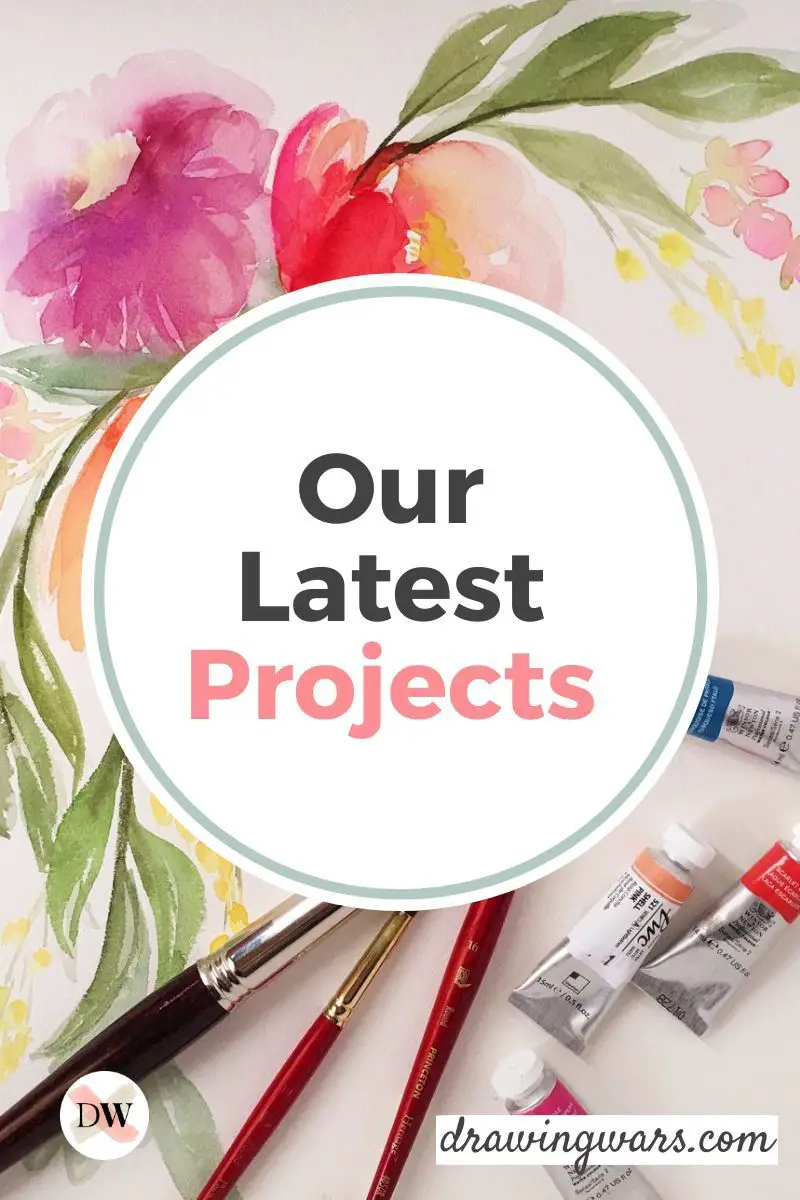

Introduction
Watercolor is the medium that people either find easy or hard. It all comes down to how you choose to use it. If you have practiced well on the various textures and techniques with watercolor, it’s the most rewarding painting medium ever. You can paint all types of subjects with watercolor, so it is as versatile as any other medium. But there are other painting media that make things easier because of how you can control them and the materials and resources involved.
Watercolor is considered the most difficult painting medium due to the little flexibility in fixing mistakes. However, it’s the easiest because of the little requirement of extra materials to paint.
Watercolor vs Acrylic
The common ground for these two media? Both of them are water-based!

Watercolor and acrylic are water-based painting media. But the support for both varies, namely paper and canvas. With acrylic paints, achieving thicker textures and fixing mistakes is easier.
Watercolor and acrylic can have quite similar techniques. They both need water, but since they have opposite binders, they could act differently. And hence, one medium is easier to handle than the other.
The binder in watercolor is gum arabic, whereas acrylic paints have polymer as its binder. This gives acrylic its plastic look and thick texture. You can go both thin and thick with acrylic paints, whereas with watercolor, you cannot achieve the 3D-like thick texture or thickness, in general, is hard to obtain. Even if you’re using the most opaque watercolor paints, it doesn’t amount to same the effect and painting that an acrylic painting can give.
Watercolor vs Acrylic:
Acrylic paints are generally much easier than watercolor. It is because you can fix mistakes easily in an acrylic painting. With watercolor, whatever goes onto paper, stays there. So you need to do a lot of planning before making a watercolor painting.
On the other hand, removing mistakes in an acrylic painting is easier. Just apply some gesso on the area of the painting that you want to fix.
Watercolor vs Oil
These two media are at the opposite ends of the painting spectrum!

Watercolor simply requires water to create a painting. Whereas, traditional medium requires other mediums, that are generally more complicated to use than water.
Traditional oil painting needs linseed oil and turpentine. The spirit of turpentine is used to create thin washes and glazes of oil paint. Whereas, you can use linseed oil to create thicker textures of paint. Although now there are water mixable oil paints available too, and that has made the medium more accessible and easier.
Although oil may sound like a more difficult medium, artists that started painting with oil usually find it easier. And it’s because oil painting gives you the power to start over any time. So even if you don’t like your entire painting, you could just remove it and begin again!
PRO-TIP
use turpentine
Are you afraid of making mistakes in your oil painting? Use turpentine to remove anything from your oil painting. Just wipe it off with a paper towel.
Watercolor vs Oil: The easier medium
In terms of clearing up mistakes, oil painting is the best. Oil paints are very forgiving and even if you started your painting journey with watercolor, you’ll find oil painting easier. Art companies have also started producing water mixable oil paints. So that’s even better as it can make the process easier.
Watercolor vs Gouache
Watercolor and gouache are like siblings!

Gouache is an opaque water-based medium. While it may resemble watercolor, it requires different technique for mastery.
The most basic difference between watercolor and gouache is the thickness. Gouache is thick, whereas watercolor is naturally thinner - even if you buy the matt or opaque forms of watercolor. You can think of gouache as a painting medium that’s between watercolor and acrylic.
But what makes gouache different from watercolor when it comes to painting? Well, the primary method varies - you need to use gouache like a cream and thick inky liquid rather than creating a watery mixture.
Due to the varying opacity, watercolor and gouache both have different techniques. Technically speaking, you can get more flexibility with a gouache painting than a watercolor one. If you have been looking forward to getting gouache paints, we highly recommend you get this one .
Art Supply Professional Color Gouache
Set of 36 gouache paints by Art Supply. Using these on watercolor paper is the best.
Watercolor vs Gouache: The easier medium
Painting with gouache can be easier compared to watercolor. Although gouache is more chalky in appearance, you can rework it as many times as you like. But don’t overdo it, as it may cause your painting to look messy! All in all, this is the very reason why illustrators mostly prefer gouache over watercolor for all their projects.
Watercolor vs Egg Tempera
Is watercolor easier than the traditional medium of egg tempera?
Egg tempera is an ancient technique that many traditional artists still use to this date. A striking difference between watercolor and egg tempera is that tempera can also be used on wood panels. Both wood and paper are excellent supports for egg tempera painting.
On the other hand, watercolor is mostly used only on paper. It can be used on canvas too but you would need to prepare it with the watercolor ground. A canvas is not the most ideal support for watercolor painting.
Watercolor vs Egg Tempera: The easier medium
Watercolor is definitely easier than egg tempera! Working with egg tempera means you need to find the right balance of the egg binder. This can make it more difficult than watercolor, which only requires water.
The egg tempera technique is also harder and creates a very thick layer, that can easily get scratched if not covered and protected properly. With watercolor, you can easily use acid-free archival paper for protection even if you decide not to frame your painting.
That being said, there is also a chance of wasting lots of eggs too if you’re doing an egg tempera painting. So yes, watercolor is the clear winner against egg tempera!
Watercolor vs Fresco Painting
Fresco is yet another traditional painting method!
Painting on plaster with watercolor is highly unlikely. And this is what creates the primary difference between these two painting media.
Fresco painting is mostly done for murals. It is meant to go directly on the walls, with the works being dedicated to architectural decoration or even if they are free-form, they are medium or large scale.
Watercolor is not meant to go on plaster. Even if you prepare the watercolor ground, it’s not the most ideal medium for that architectural purpose because it’s prone to fading away when exposed to a lot of light.
Watercolor vs Fresco: The easier medium
Watercolor is a clear winner against fresco. Fresco painting requires plenty of time, dedication and practice. It is also a different medium altogether, ideal for architectural purposes.
Conclusion
It all comes down to practice. Most painting media are easier than watercolor paints because it’s simple to remove mistakes. However, not all media work with all types of support. And for watercolor, But if you’re excellent at controlling various watercolor techniques, you could find this fascinating medium as easy as the other ones.
Are you eager to learn more about art mediums? Don’t miss this post on 9 different art mediums, ranked for beginners !
What are Art Mediums? 9 Best Mediums Ranked for Beginners
Drawing and painting - there are so many mediums for both! But which ones should you try out as a beginner?

By Jimena & Iñigo
The Navarro-Rubios
My husband and I are learning how to draw and paint. We wanted to share this learning process with the world and have fun! That's why we created this blog. We'll have drawing contests every week and you'll decide who won that week! Follow along and learn with us!

Jimena & Iñigo
The Navarro-Rubios
My husband and I are learning how to draw and paint. We wanted to share this learning process with the world and have fun! That's why we created this blog. We'll have drawing contests every week and you'll decide who won that week! Follow along and learn with us!








